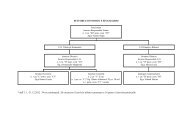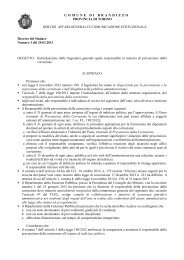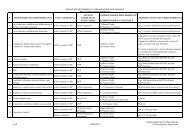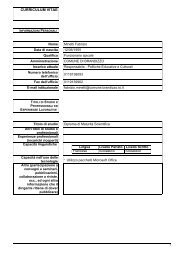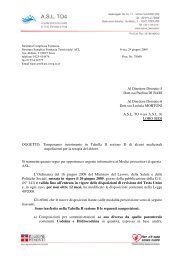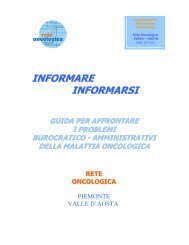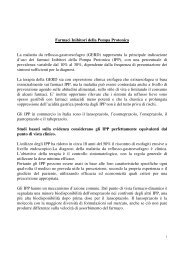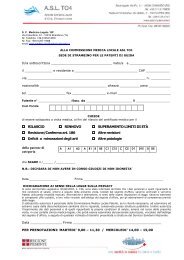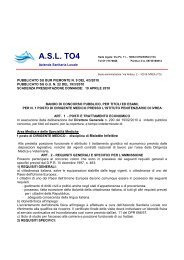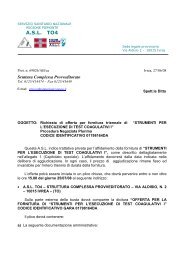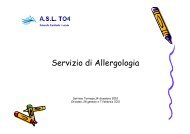Articolo sulla casistica delle non idoneità allo sport agonistico in ...
Articolo sulla casistica delle non idoneità allo sport agonistico in ...
Articolo sulla casistica delle non idoneità allo sport agonistico in ...
Create successful ePaper yourself
Turn your PDF publications into a flip-book with our unique Google optimized e-Paper software.
BODY EQUILIBRIUM AND CONNECTIVE TISSUE GALLOZZI<br />
the entire cell; the nucleus and cell cytoplasm<br />
are therefore decentralised and flattened aga<strong>in</strong>st<br />
the periphery of the plasma membrane;<br />
— the multilocular adipocytes, on the other<br />
hand, do not have a central vacuole but present<br />
fats <strong>in</strong> numerous t<strong>in</strong>y droplets scattered <strong>in</strong> the<br />
cytoplasm. The nucleus of these cells is located<br />
centrally.<br />
The extra-cellular matrix<br />
The extra-cellular matrix (ECM) consists of<br />
<strong>in</strong>soluble proteic fibres (collagen, elastic and<br />
reticular) and basic substance.<br />
THE INSOLUBLE PROTEIC FIBRES OF THE ECM<br />
Elastic fibres.—These yellow fibres predom<strong>in</strong>ate<br />
<strong>in</strong> the elastic tissue and hence <strong>in</strong> areas of the<br />
body where particular elasticity is required (e.g.<br />
pavilion of the ear, sk<strong>in</strong>, blood vessels contribut<strong>in</strong>g<br />
to blood circulation efficiency). The<br />
elastic fibres are f<strong>in</strong>er than collagen fibres, they<br />
are ramified and unite to form an irregular reticulate,<br />
and they yield readily to traction, resum<strong>in</strong>g<br />
their orig<strong>in</strong>al shape when the traction ceases.<br />
The ma<strong>in</strong> component of these fibres is elast<strong>in</strong><br />
scleroprote<strong>in</strong>, which is much younger <strong>in</strong> evolutionary<br />
terms, than collagen.<br />
Reticular fibres.—These are very f<strong>in</strong>e fibres<br />
and are considered to be immature collagen fibres<br />
<strong>in</strong>to which to a large extent they are transformed.<br />
They are present <strong>in</strong> great quantities <strong>in</strong> embryonic<br />
connective tissue and <strong>in</strong> all parts of the organism<br />
<strong>in</strong> which collagen fibres form. After birth<br />
they are particularly abundant <strong>in</strong> the structure of<br />
hematopoietic organs (e.g. spleen, lymph nodes,<br />
red bone marrow) and form a network around<br />
the cells of the epithelial organs (e.g. liver, kidneys,<br />
endocr<strong>in</strong>e glands).<br />
Collagen fibres.—These are the most numerous<br />
fibres, they constitute about 15% of the body mass<br />
and give a white colour<strong>in</strong>g to the tissue <strong>in</strong> which<br />
they are present (e.g. tendons, aponeurosis, organ<br />
capsules, men<strong>in</strong>ges, corneas). They make up the<br />
framework of many organs and are the strongest<br />
components of their stroma (support tissue). They<br />
present long, parallel molecules which take the<br />
form of microfibrils and then long, tortuous bundles<br />
held together by a cemented substance conta<strong>in</strong><strong>in</strong>g<br />
carbohydrates. These fibres are highly<br />
resistant to traction and the lengthen<strong>in</strong>g they are<br />
subjected to is quite negligible (Figure 2).<br />
secrezione dei lipidi, svolgendo così sia una funzione<br />
di riserva energetica, sia contribuendo al<br />
riscaldamento del corpo. Gli adipociti esistono <strong>in</strong><br />
due varietà: gli adipociti uniloculari e gli adipociti<br />
multiloculari:<br />
— gli adipociti uniloculari presentano un unico<br />
grande vacuolo, contenente i lipidi, che riempie la<br />
quasi totalità della cellula. Il nucleo ed il citoplasma<br />
cellulare risultano perciò decentrati e schiacciati<br />
lungo i bordi della membrana plasmatica.<br />
— gli adipociti multiloculari <strong>non</strong> possiedono<br />
<strong>in</strong>vece il vacuolo centrale, ma presentano i lipidi<br />
raccolti <strong>in</strong> numerose piccole gocce disperse nel citoplasma.<br />
In queste cellule il nucleo si presenta <strong>in</strong><br />
posizione centrale.<br />
La matrice extra-cellulare<br />
La matrice extracellulare (MEC) è composta da<br />
fibre proteiche <strong>in</strong>solubili (collagene, elastiche e reticolari)<br />
e sostanza fondamentale.<br />
LE FIBRE PROTEICHE INSOLUBILI DELLA MEC<br />
Fibre elastiche.—Queste fibre gialle predom<strong>in</strong>ano<br />
nel tessuto elastico e qu<strong>in</strong>di <strong>in</strong> zone del corpo<br />
dove è necessaria una particolare elasticità (es.<br />
padiglione auricolare, cute, vasi sanguigni nei quali<br />
contribuiscono all’efficienza della circolazione<br />
del sangue). Le fibre elastiche sono più sottili <strong>delle</strong><br />
fibre collagene, si ramificano e riuniscono formando<br />
un reticolato irregolare, cedono facilmente a forze<br />
di trazione riprendendo la loro forma quando la trazione<br />
cessa. Il componente pr<strong>in</strong>cipale di queste fibre<br />
è la scleroprote<strong>in</strong>a elast<strong>in</strong>a, alquanto più giovane,<br />
<strong>in</strong> term<strong>in</strong>i evolutivi, del collagene.<br />
Fibre reticolari.—Sono fibre molto sottili e sono<br />
considerate come fibre collagene immature nelle<br />
quali <strong>in</strong> gran parte si trasformano. Sono presenti <strong>in</strong><br />
grandi quantità nel tessuto connettivo embrionale<br />
e <strong>in</strong> tutte le parti dell’organismo <strong>in</strong> cui si formano<br />
fibre di collagene. Dopo la nascita esse sono particolarmente<br />
abbondanti nell’impalcatura degli organi<br />
ematopoietici (es. milza, l<strong>in</strong>fonodi, midollo rosso<br />
<strong>delle</strong> ossa) e costituiscono una rete <strong>in</strong>torno alle cellule<br />
degli organi epiteliali (es. fegato, rene, ghiandole<br />
endocr<strong>in</strong>e).<br />
Fibre collagene.—Sono le fibre più numerose,<br />
costituiscono circa il 15% della massa corporea ed<br />
impartiscono al tessuto <strong>in</strong> cui sono presenti colore<br />
bianco (ad es. tend<strong>in</strong>i, aponeurosi, capsule degli<br />
organi, men<strong>in</strong>gi, cornee). Formano l’impalcatura<br />
di molti organi e sono i componenti più resistenti del<br />
loro stroma (tessuto di sostegno). Presentano mole-<br />
Vol. 62, N. 4 MEDICINA DELLO SPORT 389



